California Country Club
In 1917, Culver City founder Harry Hazel Culver (1880-1946) helped start a country club near where he would live in Castle Heights. Initially called the “Culver City Country Club,” it would cover over 100 acres of Francisco Higuera’s allotment of Rancho Rincón de los Bueyes previously holding the John D. Hawes Ranch. The club would change hands at least a few times, and it changed names, as well: to California Country Club (1917-1940), Cheviot Hills Country Club (1940-1943), Rolling Hills Country Club (1944-1945), and back to California Country Club (1945-1951). It hosted business leaders, star entertainers, and the world’s best golfers, including John Byron Nelson Jr. (1912-2006) and William Ben Hogan (1912-1997). In 1950, the club’s owners – actor/director Frank Borzage (1894-1962), actor/singer Fred MacMurray (1908-1991), Hollywood manager Bö Christian Roos (1903-1973), and actor/filmmaker Marion Robert Morrison (1907-1979), better known as John Wayne – sold to hotelier Sanford Dennis “Sandy” Adler (1909-1991), who developed the California Country Club Estates subdivision in its place.
Culver City Country Club (1917-1919)
The Culver City-based social group decided to establish their country club and golf course in the hills of Palms (Los Angeles), overlooking Culver City from the north, on what had been the John D. Hawes Ranch. The ranch had belonged to Chicagoan John Dunham Hawes (1876-1923), who was a Yale graduate and lawyer when he married Detroiter (and daughter of a former Detroit mayor) Edna Ora Grummond (1882-1933) in December 1905. They moved to Los Angeles on January 1, 1906. John engaged in real estate.
On April 29, 1917, the Los Angeles Times reported that the “Culver City Country Club, an organization perfected during the past week, has leased 105 acres of land in the rolling hills just north of Culver City and plans to at once build a clubhouse and lay out a golf course.” “The club has obtained a twenty-year lease of the property secured …. Plans for the clubhouse, which will stand upon a high knoll commanding a sweeping vista of the city, the valley and the ocean, are now being drawn by A. S. Heineman.”
The paper told the story of a picnic on the grounds at which officers were elected: George W. Somerville (c. 1858-1937) would be president; Culver City founder Harry Culver was elected vice-president; Harry W. McNutt (c. 1874-1932) was to be secretary; and Edwin Hampton (“E. H.”) Allen (1885-1942), would serve as treasurer. Seven directors were also chosen: Harry H. Culver, Charles Rossiter Stuart (1881-1974), H. W. McNutt, George W. Somerville, J. F. Haight, E. H. Allen, and John D. Carson. The club’s “18-hole golf course opened in 1917 with Jack Stone and Hutt Martin as professionals.” (Golf Historical Society, “California Country Club, Culver City, California.”)
The club’s founders were well-known at the time – though Harry Culver is the only one whose name is usually attached to the club, which is understandable, since his name is attached to a nearby city. See, e.g., Golf Historical Society’s “California Country Club, Culver City, California.”) Charles R. Stuart was a “prominent Hollywood financial figure.” (LA Times, Nov. 1, 1925.) H. W. McNutt (c. 1874-1932) was an attorney; George W. Somerville; and Edwin Hampton (“E. H.”) Allen (1885-1942) was a producer and actor. Architect and contractor Arthur Seelman “A. S.” Heineman (1878-1972) (who was said to be drawing up the clubhouse plans) would provide those services to club officer and director (and Culver City baker) J. F. Haight. (Southwest Builder and Contractor, Jan. 11, 1918, p. 16.)
On June 22, 1917, the aforementioned Los Angeles Trust & Savings Bank filed a “notice of non-responsibility for any improvement on the John D. Hawes Ranch, sometimes known as the Culver City Country Club.” Thus, work could go forward on the new club without any construction liens against the bank. (Southwest Builder and Contractor, June 30, 1917, p. 33.)
The club’s founders described finding the site for the Culver Country Club, which would open as the “California Country Club”:
Less than two years ago, several clubmen met by appointment in a lemon grove, just north of Culver City, says the press representative of the Culver City Golf Club.
The ungroved acres round about them were barley fields. They followed the driveway, drove past the ranchhouse, and reached the highest point on the acreage. From this vantage point was spread out before them and unexpected view. Beyond doubt this was the highest knoll between Los Angeles on the east and the sea on the west. Mountain, city, valley and sea presented a panorama not to be duplicated anywhere in this part of the country. The grounds were undulating, dotted here and there with small groves of growing shade trees.
It wasn’t ground particularly adapted to farming, but it was an ideal location for a country club. It was near to the city, near to the sea; near boulevards and crossroads, making it peculiarly accessible. Electric lines passed its threshold, the breeze from the ocean warned it when cool and cooled it when warm.
There were five in the party, and their verdict was unanimous as to the desirability and practicability of the grounds for country club purposes.
It was all over in thirty minutes. These five successful professional and business men, Judge George W. Somerville, John D. Carson, E. H. Allen, Harry W. McNutt and Harry H. Culver had organized the Culver City Country Club.
But war had been declared. In a patriotic spirit: the ranchhouse was converted into an unassuming clubhouse, an expert was employed to lay out the golf course. It was to be made an eighteen-hole course.
The entire course was scraped and resown in alfilaria and lawn clover. ….
January 13, 1919, L. A. Times.
In August 1919, the Los Angeles Times dedicated nearly a full-page to covering the nascent country club, under the heading “When Rancho Turns Country Club“:
Whether or not those who twenty-five years ago planted the long avenue of pepper trees at the John D. Hawes Ranch had the far vision when they set out the slender saplings which eventuated in that shady driveway, the invitation which it extends to the approaching visitor is an impressive harbinger of the welcome given by the home, old-time house, with its surrounding trees and shrubbery, at the Culver Country Club.
The 200 or more acres are, in fact, framed in trees, a line of tall eucalyptus extending entirely around the plot.
The Culver City Club, a mere name … was launched into verity a few months ago, and it already boasts an active membership of about 200.
The annual outing of the Optimist Club took place at the Culver Country Club ….
In the liberty tournament … Mr. Walter Ralphs is a champion.
The clubhouse … is the old ranch house ….
The Palms hills stretching their heads beyond Culver City, catch the ocean breeze, and also partake of the coolness of the mountain air. The Culver Country Club possesses as its chief treasure the highest of these hills. It is upon one of these that the plan is to place the new clubhouse ….
an extensive bathing pool will occupy the site of the one-time reservoir, and when further arrangements are made for an ample supply of water for the entire 200 acres wide stretches of green turf, sunken gardens and other horticultural dreams will materialize.
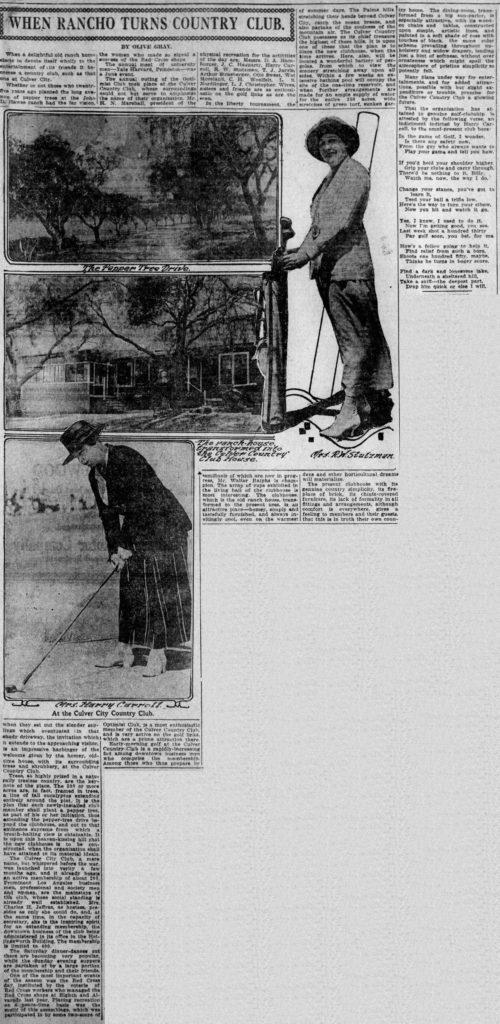
California Country Club (1919-1940)
In October 1919 the club’s name changed to California Country Club.
The Culver City Country Club petitioned the courts yesterday, to change the name to the California Country Club. The reason assigned is that it has ceased to be a local club and is confused with Culver City real estate business.
L. A. Times, Sept. 23, 1919.
In January 1920, the Los Angeles Times reported that “The club grounds and golf course comprise a site of fifty-seven acres just off the National boulevard at the outskirts of Los Angeles.” “The plans, prepared by H. H. Whitely, call for an expenditure of approximately $45,000.” “The officers and directors of the California Country Club include Harry H. Culver, president; Watt L. Moreland, vice-president; George D. Bavin, vice-president; H. W. McNutt, secretary; Mrs. C. J. Jeffries, assistant secretary; John D. Carson, treasurer; and D. A. Hamburger, J. D. Carson, William McSchane, G. D. Bavin, H. W. McNutt and H. H. Culver, directors.”

Reed Heustis (1882–1957) covered the club for the May 10, 1920, Los Angeles Evening Herald, penning a humorous piece accompanied by a Wyn Barden (?-1937) cartoon. (Heustis and Barden worked on a number of Herald articles together; Heustis also wrote for the movies.)
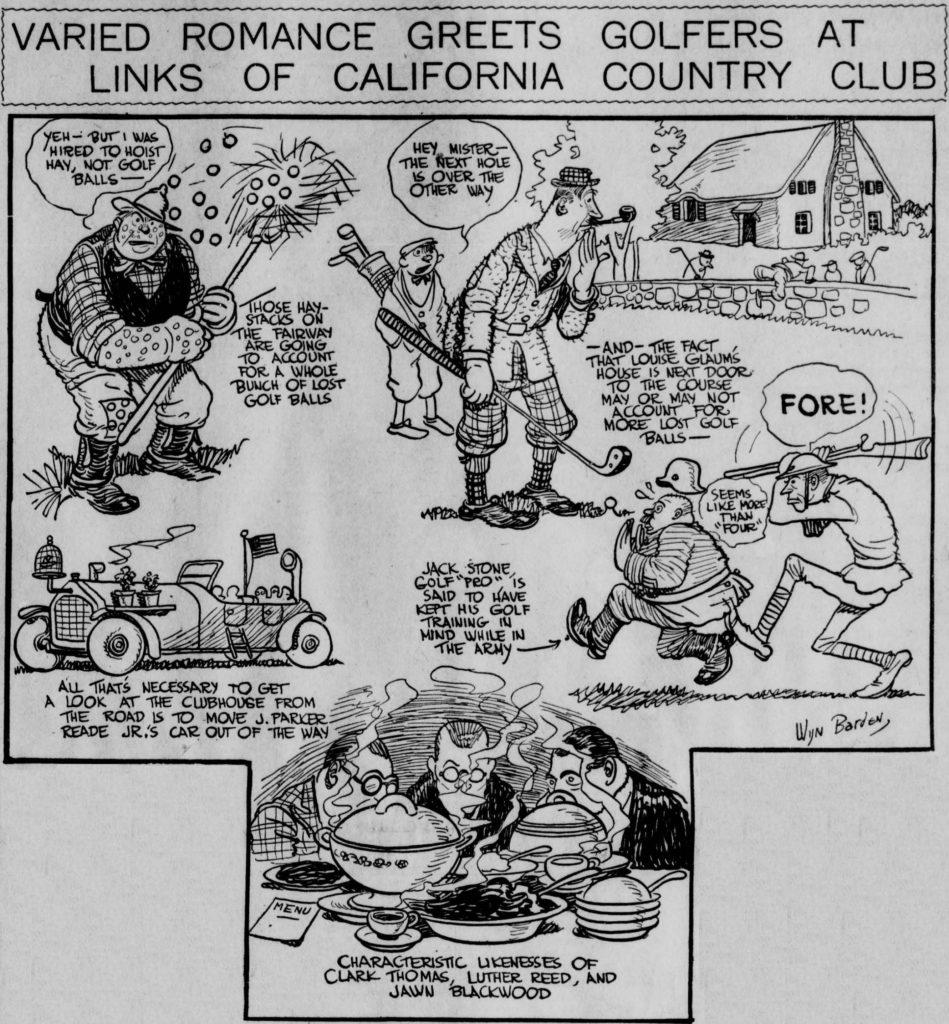
The California Country club links is a place of romance – and 18 holes. The touches of romance come in the shape of rustic old buildings; pepper trees sheltered vales where a golfer, miscuing a stroke, may make his lamentation to high heaven in the secure knowledge that no part of his outburst will reach ears for which it was not intended.
And if that isn’t romance, then what is? The crowning touch of the romantic stuff, however, comes in the shape of Luise Glaum‘s – wait a minute – house. Miss Glaum is the film actress. Her home lies hard by the golf links.
Heustis reported that Frank McGregor, “a canny Scotsman,” was club steward and Jack Stone was the club professional.
The California Country Club formally opened on March 12, 1921. The Times reported that the Spanish mission style clubhouse and the sixty-by-eighty-foot swimming pool were under construction. Two dining rooms, a drawing room, and the mezzanine provided space for over 600 members and their guests who dined and danced. That evening, Harry Culver called their attention to the “unusual view of the surrounding country” from “a high hill one mile from Culver City proper” where clubhouse windows overlooked a nighttime “panorama of scintillating lights and sky reflections on all sides.” Culver also said that the club, which had existed for three years, had reached it 500-person limit, including “many prominent businessmen of Los Angeles and Culver City especially those who are ‘addicted’ to golf.”
The club’s ranks were filled with Los Angeles’ luminaries. Harry H. Culver was president. Vice-president Watt Loren Moreland (1879-1959) had founded the Moreland Motor Truck Company. Treasurer John D. Carson (at least in 1920) was “Assistant Trust Office in Charge of Subdivisions, Trust Department, Los Angeles Trust and Savings Bank” (L. A. Times, Nov. 15, 1920). Director David Asher “D. A.” Hamburger (1857-1944) was a Harvard-educated lawyer who “joined his brother and father in A. Hamburger & Sons, which in 1881 opened The People’s Department Store in downtown L. A., catering to working-class customers. Not just a merchant and real estate developer, David Hamburger also was a columnist and Jewish community voice, writing several editorials for the B’nai B’rith Messenger.” (Jewish Journal, Aug. 30, 2017.) Director William Andrews (“W. A.”) Clark, Jr. (1877-1934) was a Los Angeles-based philanthropist and the youngest surviving son of copper baron and U. S. Senator William Andrews Clark, Sr. (1839-1925). Clark founded the Los Angeles Philharmonic and helped fund the Hollywood Bowl. He also built UCLA’s William Andrews Clark Memorial Library. Director Dr. Thomas Jefferson “T. J.” Ruddy (1876-1972) was a renowned osteopath. Director George Washington Somerville (c. 1855-1937) had been a Minnesota senator and was a judge.
Shortly after the opening dinner dance, a rumor spread that the club would be sold for oil development.
An oil boom has struck Culver City, threatening to wipe the California Country Club out of existence in its present locality. According to a rumor which persisted in our local golf circles yesterday the club is said to have been offered the lumpy sum of $350,000 and 12 percent in royalties for permission to drill oil wells on the property.
L. A. Times, May 7, 1921.
The links of the club are declared to be resting atop a huge bed of oil, ready to spout forth streams of dollar-making fluid.
The California club is one of the newest clubs in the south. After an unfortunate start with its grass greens, due to the hiring of a man who had no previous experience except with sand greens, the club has been making splendid progress with its course and plans have been going forward for a grand opening tournament next fall.
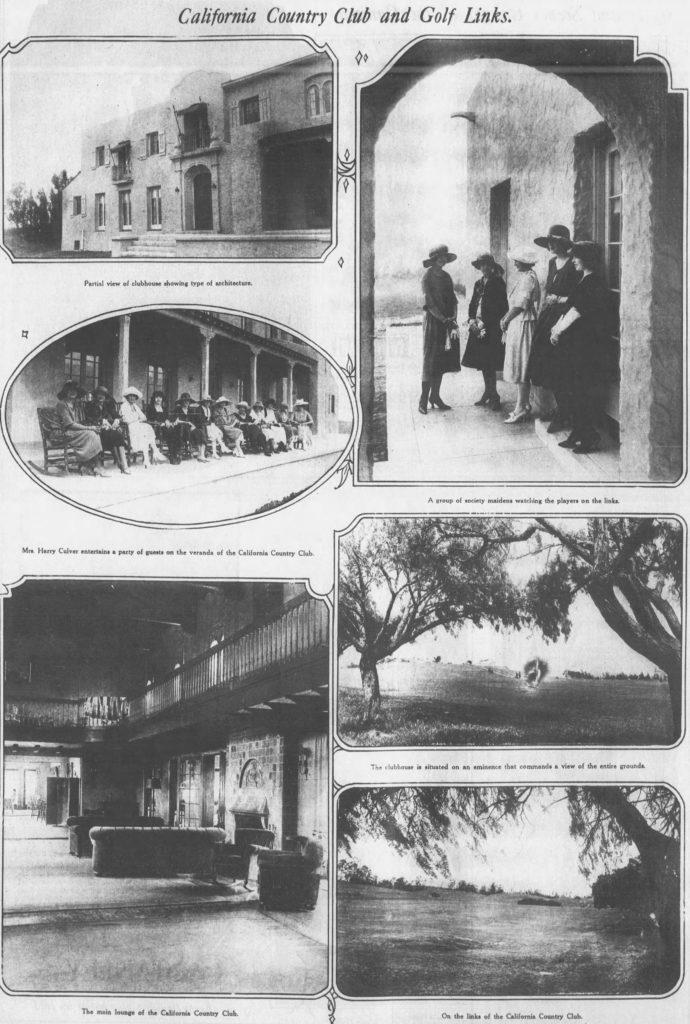
The club was a featured amenity as neighborhoods grew up around it. In 1922, the Castle Heights development was advertised as “Adjoining the California Country Club.” In 1925, Monte-Mar Vista’s developers promoted their location: “Direct entrance to the California Country Club on the southern border.” In 1939, the Leimert Company, promoting its Cheviot Knolls subdivision, touted the “Famous California Country Club and the Westside Tennis Club with a membership of champions and motion picture stars adjoin these gently sloping hills, with Rancho Public Golf Course 5 minutes away.” As late as 1949, Beverlywood-area builders Weber & Diller boasted that their houses were “nearby California Country Club and Rancho Public Golf Course.”
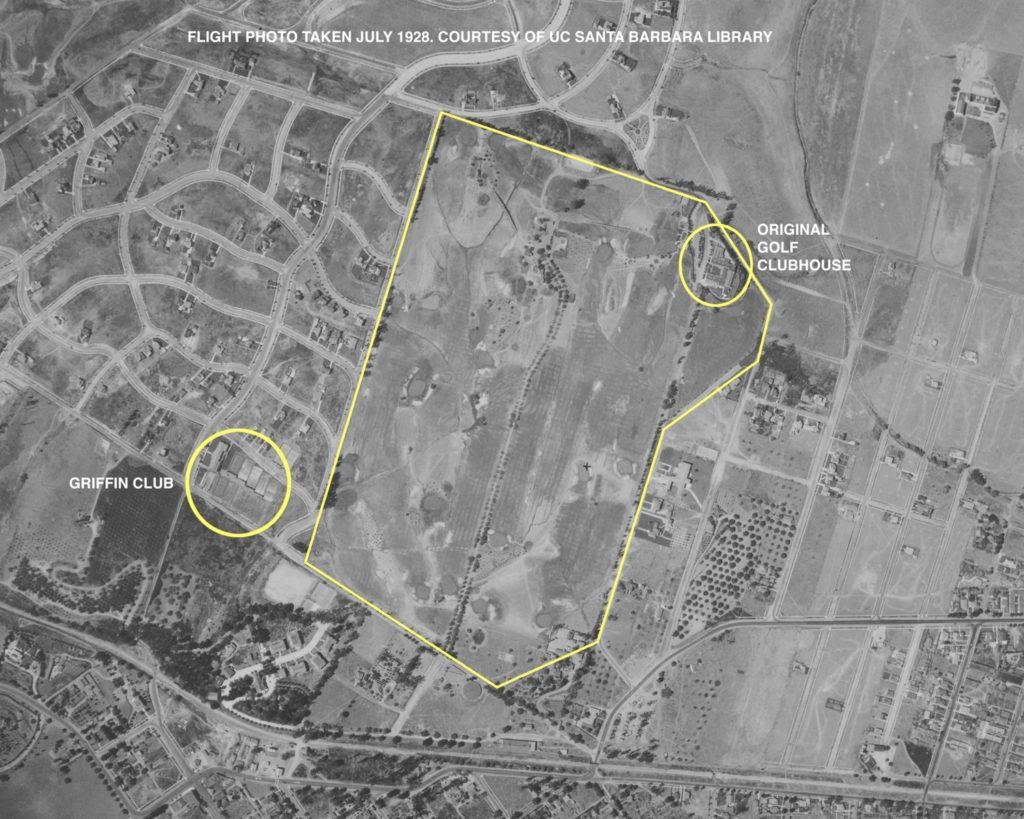
The club hosted frequent community events.
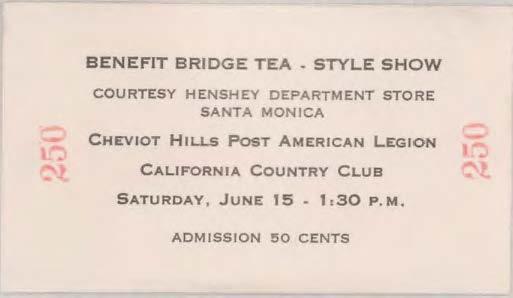
In 1934, club president, Fred Ussher, announced “an initiation fee for membership.” (L. A. Times, Oct. 26, 1934.)
Cheviot Hills Country Club (1940-1943)
The Cheviot Hills Garden Club history recalled that, in 1940-1941, “Plans were under way to organize the Cheviot Hills Country Club to take over the California Country Club which had gone under financially.” Reorganization as the former was reported in December 1940. The September 28, 1941, Los Angeles Times told that, even with the change, there were still problems:
Although the tangled financial affairs of Cheviot Hills Country Club leave the ultimate future of the organization a doubtful matter, it will definitely continue operations until the first of the year, according to Ed R. Hurst, the just-retired president of the club.
“We have a lease until Jan. 1, and all bills are paid until that date,” Hurst says.
Although the tangled financial affairs of Cheviot Hills Country Club leave the ultimate future of the organization a doubtful matter, it will definitely continue operations until the first of the year, according to Ed R. Hurst, the just-retired president of the club.
“We have a lease until Jan. 1, and all bills are paid until that date,” Hurst says.
A group is attempting to bring in sufficient new members to keep the club, known for many years as the California Country Club, going on a sound basis. Hurst’s resignation, as well as that of the entire board of directors, becomes effective Oct. 1.
The United States entered World War II just over a month later, so the membership drive could not have gone well. Plus, Hurst, “an early member, past president and an honorary life member of the California Country Club,” would die a couple of years later. Edward Randolph Hurst (1880-1943) was a local realtor – the primary seller of the Cheviot Hills and Cheviot Knolls tracts. He “was stricken at a Mexico City golf club where he had played the previous day.” Hurst “became associated [in 1929] with Harold G. Neff, with whom he developed the Cheviot Hills residential section, of which he was an early resident.” (L. A. Times, Nov. 14, 1943.) In 1934, he lived at 3049 Queensbury Drive when the Canadian native became a naturalized citizen. He left a widow, Margaret Lenore “Nora” (Kellogg) Hurst (1878-1959), at 10327 Cheviot Drive.
In 1942, Alexander Hamilton High School’s Alumni Association held its Homecoming (Federalist, March 20, 1942) and a Prom (Federalist, May 28, 1943) at the Cheviot Hills Country Club. Prom was held there again in 1943. (Federalist, Jan. 8, 1943.)
In June 1943, the public Cheviot Hills Country Club “folded” due to “financial difficulties.” (L. A. Times, Feb. 6, 1944.)
Rolling Hills Country Club (1944-1945)
In February 6, 1944, the Los Angeles Times covered the club’s reopening as the Rolling Hills Country Club:
Rolling Hills Country Club today officially opens its doors and fairways as the newest private club in the Southland.
Located in the heart of Cheviot Hills, the club opens under the ownership of John Montague, golf’s erstwhile “mystery man,” and his partner Sheppard (Shep) Kelley, local sportsman.
A steam room and barbershop have been built in and the place generally overhauled with complete facilities of a luxury club. The course is in fine condition.
Membership is being strictly limited to the higher brackets with a heavy sprinkling of film, radio and war executive names. The links layout is only a few minutes from several studios and war plants.
Cheviot Hills, a public club, folded last June because of financial difficulties, same reason the California Club went out of business after years of prosperity as one of the better Southland private clubs.
Montague and Kelley took over the links a few months ago and, with material they already on hand, started remodeling the club.
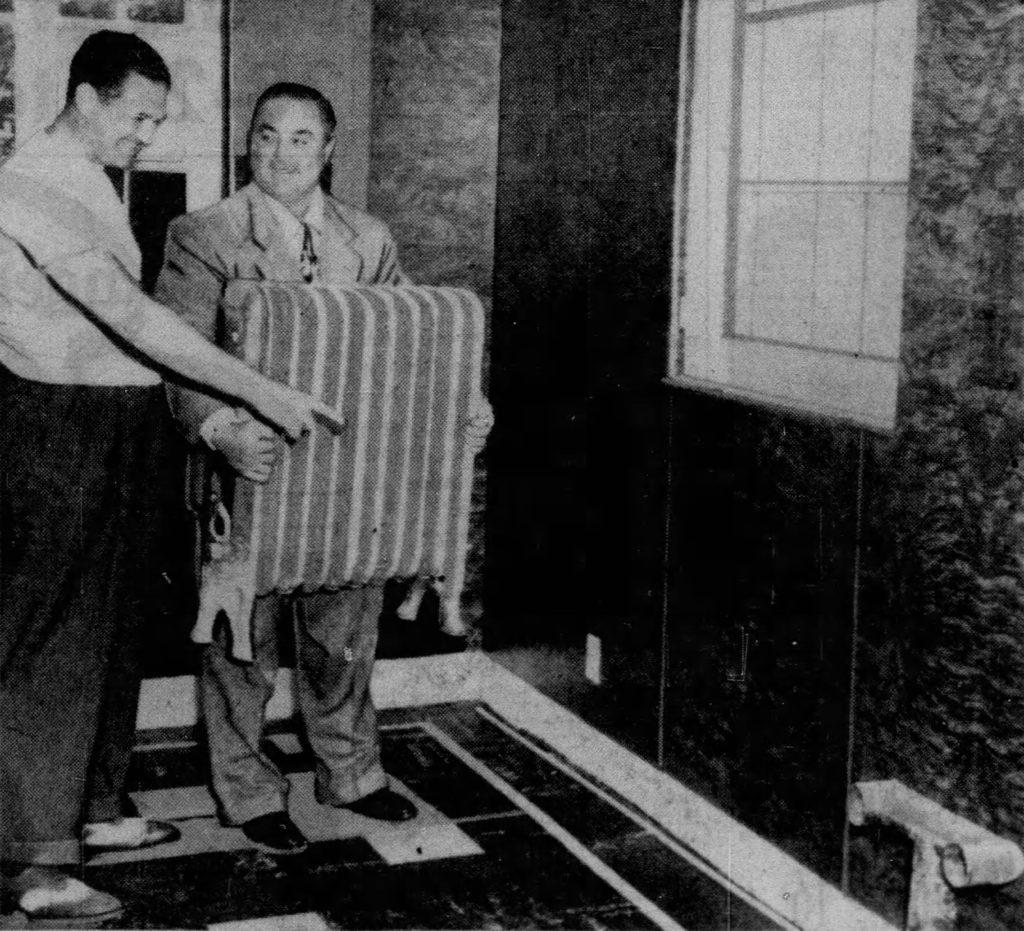
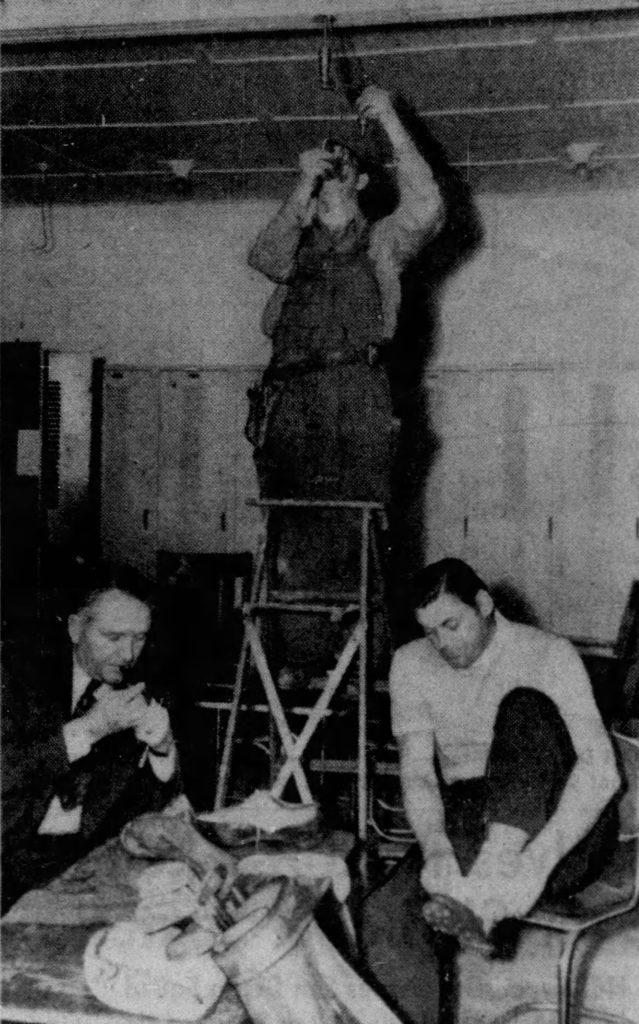
John Shepard Kelley (1903-1945) and John Montague (nee LaVerne Moore) (1903-1972) were the public faces of the reorganized club and reportedly owners. But it appears that Kelley and Montague had partners from the start: Bö Roos and his entertainment industry clients –Frank Borzage (1894-1962), Mitchell Leisen (1898-1972), Fred MacMurray (1908-1991), and Marion Robert Morrison (1970-1979) – better known as John Wayne – operating through Roos’ Beverly Managment Corporation.
Winifred Kelley (John Kelley’s widow) and John Montegue would later allege that, on November 1, 1943, John Kelley, Montague, and the Roos group agreed to buy the California Country Club for $250,000: “Club buildings were to be remodeled and refurbished … and then sold, with Montague and Kelley each to receive 25% of the net profits.”
John Montague was a colorful character and possibly a con man. Here’s part of what an obituary said:
John M. Montague, who died in Studio City Thursday at 67, was a character … one of the most familiar in California sports and movie circles in the 1930s and 1940s.
He was known by various names … La Verne Moore (his real name), “The Sphinx of the Links,” “The Mysterious Monty,” “The Phantom of the Fairways,” “The Garbo of Golf.” And he was also known by various numbers on police department blotters.
Some called him the world’s greatest strong man. Some called him a con man.
Grantland Rice [1880-1954] said he was “the greatest golfer on earth. Westbrook Pegler [1894-1969] dubbed him “a combination John Henry, Paul Bunyan and Popeye the sailor.” Walter Hagen [1892-1969], in a serious moment, said that “Monty is the most amazing golfer in the world.”
Arthur Abrams, a Los Angeles photographer with whom Montague was formerly associated, says that he was a rum runner on the St. Lawrence River in the Al Capone days.
In the same era, he reportedly passed himself off as a policeman in a minor extortion racket in New York state, drawing a suspended sentence.
Some of Monty’s friends included many of Hollywood’s biggest names – Oliver Hardy [1892-1957] (with whom he lived for some time), [Bing] Crosby [1903-1977], Spencer Tracy [1900-1967], Bob Hope [1903-2003], Richard Arlen [1899-1976], W. C. Fields [1880-1946], Guy Kibbee [1882-1956] and Johnny Weissmuller.
He had baseball tryouts as a pitcher with both the Boston Braves and New York Yankees. Babe Ruth be-friended him ….
In 1938, Montegue married Mrs. Esther Plunkett, a wealthy Beverly Hills matron.
“He made and lost a million dollars several times,” said Abrams.
Bö Roos was famous in his day, too. The New York Times carried his obituary:
Bö C. Roos Sr., one of Hollywood’s leading business managers, with clients including John Wayne, Fred MacMurray, Red Skelton and Lloyd Nolan, died yesterday at the age of 69.
Because of his flamboyant, high‐powered and hectic way of life, Bö (pronounced Boo) Roos could have been the model for the movie stereotype of the Hollywood business manager.
A bulky, well‐tailored man with cold blue eyes and a pencil mustache, he made about 60 phone calls a day, commuted by plane around the world, worked with his clients, played poker with them, went to Mexico with, them and was said even to Weep with them.
For more than 30 years he handled private investments of Hollywood’s top screen stars, which in a typical year amounted to $7‐million, and battled with the Internal Revenue Service for them.
His clients had also included Marlene Dietrich [1901-1992], Joan Crawford [190?-1977], Merle Oberon [1911-1979], Carole Landis [1919-1948], Lupe Velez [1908-1944], Frank Borzage, Johnny Weissmuller and George Brent [1904-1979].
A Rolling Hills clubhouse gambling arrest got coverage in 1944, with the press reporting “Thirty-five men were taken into custody … when they were found assertedly engaged in five stud poker games at the Rolling Hills Country Club, 3100 Club Drive, West Los Angeles.” (L. A. Times, April 14, 1944.) “John Montague, the widely publicized trick golfer, was proprietor of the club but was not present.” “Lt. J. R. Steward, night chief of the Los Angeles vice squad, said he and Sgt. F. E. Durham “visited the club several days ago and talked to Montague about its operation. Late [that] night they returned in plain clothes with five other officers and watched play for 10 minutes before taking the men to the station.” (Ibid.) “One $50 pot and a slot machine were taken for evidence.”
Bail of $100 each was promptly posted, and the case was resolved days later. The attorneys for the “32 physicians” and one undertaker, “told the court the doctors had engaged the club for a dinner and lecture and that afterward some of them got up a ‘friendly little game of penny ante.’ The court, remarking that there was no evidence of commercialized gambling, dismissed a Penal Code count and on the plea of guilty to violation of the municipal ordinance sentenced the defendants to $10 or five days in jail each.” The undertaker paid the fines – as he had the bail). (L. A. Times, April 18, 1944.) The latter report did not mention the slot machine.
California Country Club (1945-1951)
The name-change back to California Country Club came in August 1945, around the time of John Kelley’s separation from the club and not long before his death. “John Shepard Kelly, 41, restaurant owner” “until recently … part owner of the Rolling Hills Country Club” died on November 16, 1945. (L. A. Times, Nov. 21, 1945.) On August 12th, the Times referred to “California Country Club (nee Rolling Hills).” Days earlier, on August 3, 1945, the paper had reported on Frank Borzage’s initial celebrity tournament at the “Rolling Hills,” So, the name apparently changed that week.
John Montague remained associated with the club in some reports (an August 18, 1945, article calls Montague the club pro). However, after 1946, the Bö Roos group, particularly Borzage, would become more prominent in the coverage, while Montague’s name disappeared.
The club’s war-time reorganization is touched on by Michael Sydney “Sid” Luft (1915-2005) in his biography when he wrote of playing golf after working as a test pilot for Douglas Aircraft at nearby Clover Field in Santa Monica:
I joined the California Country Club, which was started by Fred MacMurray, Johnny Weissmuller, and John Wayne. Bo Roos was their business manager. The men bought the land, refurbished the rundown grounds, and had a drive for membership – and I signed up. I was off work at three o’clock in the afternoon, and nearly every day I went directly to the club to play golf. I played with some amazing people: Babe Didrikson, who loved to gamble, Johnny Mercer [1909-1976], Harold Arlen [1905-1986], Ira Gershwin [1896-1983], and Swifty Lazar [1907-1993], among others.
Judy & I: My Life with Judy Garland (2017, Chicago Review Press).
In September 1945, days after the war’s end, plans were announced for a hotel:
Plans for a $2,000,000 country club hotel on the site of the California Country Club, near Culver City, were announced yesterday by the owners, Fred MacMurray, John Wayne, Mitchell Liesen, Frank Borzage and Bo Roos.
If plans are approved by property owners in the vicinity and by zoning officials, the owners said they plan to break ground Jan. 1 for a 270-room hotel, a glass-enclosed clubhouse with roof garden and dining room for 1000 guests, 35 bungalows, tennis courts, swimming pool and a four-story garage.
The construction, expected to take 12 to 18 months, will be on nine acres not now used by the golf course, William Allen and [William] George Lutzi are architects.
L. A. Times, Sept. 6, 1945.
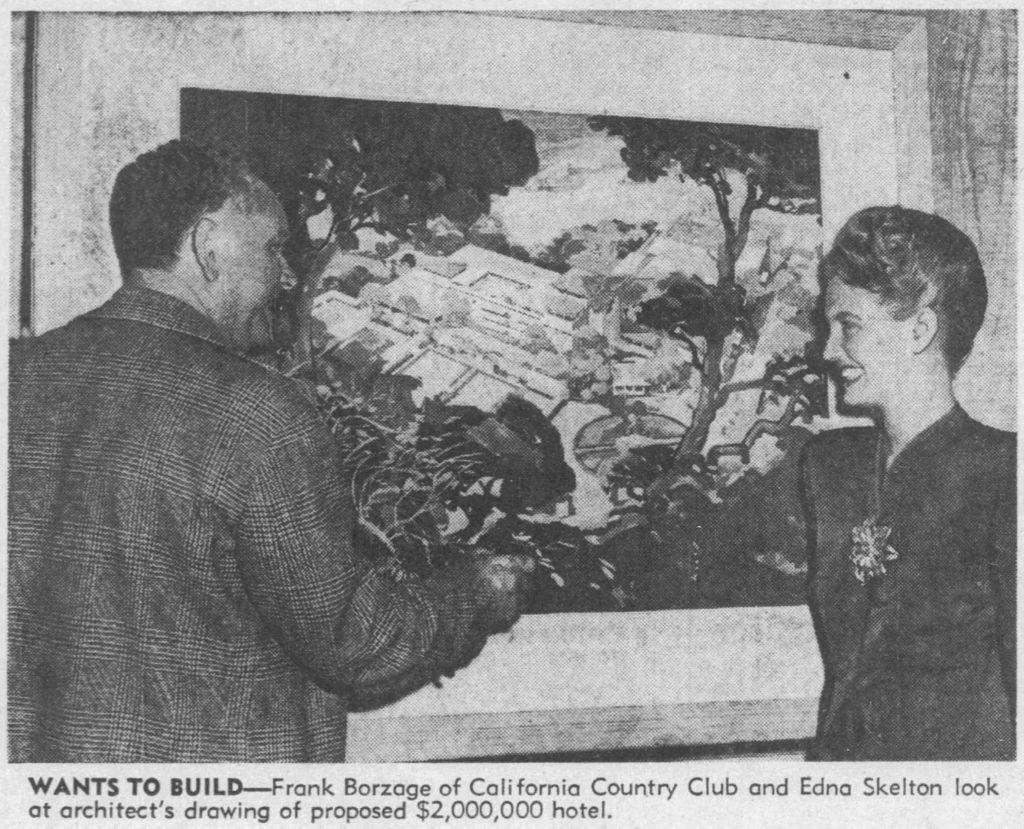
Mildred Ella “Babe” Didrikson Zaharias (1911-1956), the greatest woman golfer in her time, was not the only golfing great to grace the greens. On August 6, 1944, Byron Nelson won the $5,000 Beverly Hills at Rolling Hills Country Club. (Santa Cruz Sentinel, Aug. 8, 1944.) On September 2, 1946, Ben Hogan, won the “richest links event ever held in Southern California, the $15,000 Golden State open at California Country Club.” (L. A. Times, Sept. 3, 1946.)
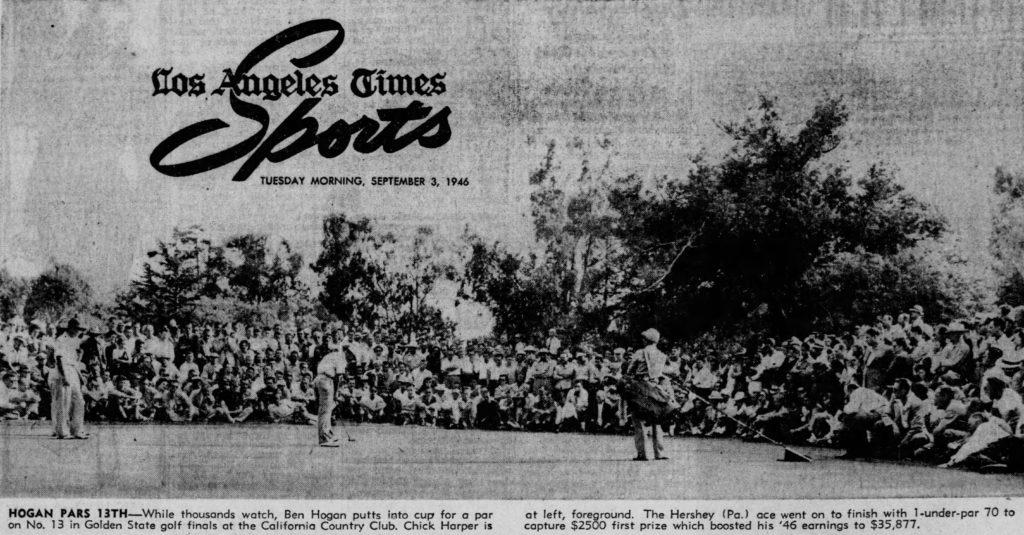
The club held its annual celebrity tournament on May 23, 1948.
“The Cancer Fund is the recipient of proceeds from today’s show, with gallery fees set at $2, including tax, and each contestant tossing in a $10 entry fee.” “Top-ranked stars who will compete include Bob Hope, Randolph Scott [1898-1987], Bruce Cabot [1904-1972], Tony Martin [1913-2012], Jack Carson [1910-1963], Wayne Morris [1914-1959], Barry Fitzgerald [1888-1961], Johnny Weissmuller and Jack [John?] Carroll [1906-1979].”
L. A. Times, May 23, 1948.
Later in 1948, the club celebrated a “Silver Jubilee Week beginning Nov. 28 [to] commemorate the 25th anniversary of the founding of the California Country Club.” Festivities included a dinner dance emceed by “Toastmaster General of the United States,” George Albert “Georgie” Jessel (1898-1981). Fred Ussher was still (or again) club president. (L. A. Times, Nov. 19, 1948.) How 1923 was determined to be the founding year is a matter for conjecture.
The October 28, 1950, Los Angeles Times, predicted the club’s sale to Sanford Adler for subdivision:
Sale of the California Country Club in Culver City to a syndicate headed by Sanford Adler is expected to be completed this week end, The Times learned last night.
For the past several years the club has been operated by an investment company [Beverly Management Company] of which Bo Roos is president. The principal owners have included Frank Borzage, John Wayne, Mitch Leisen and Fred MacMurray.
The club was one of the most popular golfing centers in the Southland during the 20s and early 30s. No indication of its future status has been given but rumors earlier held that Adler’s group planned to subdivide the property.
The October 31, 1950, Los Angeles Times, reported the sale and revived the idea that a hotel would be built:
Sale of the California Country Club for approximately $1,000,000 was announced yesterday.
The club, a 107-acre property at 2929 Club Drive between the MGM and 20th Century-Fox studios, is one of the oldest golf courses in Southern California.
It was bought by Sanford Adler and Associates, owners of the Del Mar Hotel and other holdings. The Beverly Management Corp., represented the sellers, Frank Borzage, John Wayne, Bo Roos and Fred MacMurray.
The purchase climaxed three months of negotiations, with several bidders taking part, including an organization representing club membership. The club was created in 1915 as a nine-hole course with oiled greens and sand tees.
The announcement said the present clubhouse will be rebuilt into a resort hotel, retaining the golf course and its fixtures, after present war restriction on amusement building is lifted.
The course remained open into 1951. On February 2, 1951, the Alexander Hamilton High School Federalist newspaper carried this student article, “Caddying is Profitable to Many Hamilton Boys”:
California Country Club may be just another golf course with its green rolling hills and its outstretched fairways, but to many of the boys attending Hamilton this is a place of occupation. The club is located behind Hami in Cheviot Hills. On the weekends the boys trudge up and down on the course and not just for the exercise. Take, for instance, the boy who happens to be in your physiology class. He works on Saturday and Sunday, so he will be able to take out the cute blonde who sits in front of him.
Working as a caddie is quite the life. He gets paid on the average of a dollar-twenty-five an hour. The caddie can go to work any hour of the day, depending on how much money he would care to make. Moreover, if there are any Joe movie goers reading this feature, you will be seeing most likely your favorite stars.
Among the stars seen at the club is Dean Martin, the dream boy of the girls. From the comedian standpoint there is Danny Kaye, and from the adventure side is Johnny “Tarzan” Weissmuller. Other stars attending the club are little June Haver and that man from the “Egg and I,” Fred MacMurray. [Haver would marry MacMurray in 1954.]
This may seem quite the life, but there are disadvantages, also. When caddying, the caddie always hopes to get a good player, so he won’t have to chase the ball all over the course. If he is an unlucky caddie, he’ll probably get a player that hits a rousing 120 for 18 holes. The average is usually around 80.
The regular fee for 18 holes is $3.00. The member usually tips the caddie. The average that is paid is usually $4.50. If any of the boys reading this feature have the idea of caddying at the club, here’s wishing you luck; that you don’t get stuck, holding the bag.
In his personal and informative book, Westside Stories (The Americas Group, 2017) Michael Harris tells of his caddying at nearby Rancho Golf Course, “When the Rancho Park Golf Course opened as a public facility in 1948, you had to be 13 years old to play or caddie. …. So the local kids vied to carry the golf bags.” “The green fees for an 18-hole round was $3.” (Harris, pp. 35, 139.) (The Harris book’s introduction is from an earlier, now updated/corrected, iteration of this website.)
On February 29, 1951, the Los Angeles Times reported on the club’s “fade-out.”
California Country Club, for parts of three decades one of the Southland’s most popular and famous private courses, staged what amounted to fade-out Friday night. Fred Ussher, president of California for more than 20 years, was honored by club members at a dinner that evening. A full program of golfing activity, including a pro-amateur, has been staged the last couple of days. All this is preliminary to the closing of the course within the next month or two.
Two days later, on March 2, 1951, a Los Angeles Times sports columnist shared the news that the club remained open: “The boys at the California Country Club wish it known that they are NOT closing down their golf course for some time to come and even when and if building starts on the proposed subdivision nine holes with two tees each will be available, along with the clubhouse.”
At the end of the month, the Times reported:
California Country Club … will be operated as a public course beginning tomorrow [April 1, 1951.]
Jack Gage, golf pro at the course, has leased the property for an indefinite time, or until Adler and his associates complete plans for subdivision of the Culver City links.
Gage announced yesterday that the clubhouse will also be open to the public a little later after plans for its operation are set. Green fees for the club’s opening round as a public course tomorrow will be $3.50 and regular green fees for subsequent play will be announced later, Gage said.
On April 1, 1951, auctioneer (and golfer) Milton J. Wershow (1910-1980), who had overseen (or would later oversee) auctions of many landmarks (e.g., Pacific Ocean Park rides, the Santa Ana Army Air Base), published a eulogy for the club, writing (in part):
California Country Club’s new owners held a lot drawing recently to divide the property. The bulldozers will soon mark the end of another nostalgic era in Los Angeles history.
Since its reorganization in 1943, California Country Club has been both a meeting place and melting pot for the great, near great and average Joes.
Where, but at California, could you see such prominent music-world talent as Buddy Morris, Harold Arlen, Johnny Mercer, Ira Gershwin, Harry Warren, Johnny Green and Paul Weston.
At what other club but this (where pomp and circumstance don’t exist) could you regularly see Frank Borzage, Johnny Weissmuller, Fred MacMurray, John Wayne, Dean Martin, Red Skelton, George Seaton [1911-1979] and [Frank Edgington] “Double F” Fenton [1903-1971] … to name but a handful of top-ranking movie people …
And where else could you rub elbows with some of the town’s leading manufacturers, business-men and attorneys, the Ben Swedes, Sam Barenfelds, Bernie Jaslins, Jerry Nemers [1912-1980], Norm Thelans, Ben Paysons, etc.
California Country Club was like an old shoe. It wore well. The heterogeneous group that comprised its membership often drew its laughs and camaraderie from Runyon-like characters who are part of the “California legend.”
Subdivision documents were filed days after the Los Angeles Times’ report. On April 4, 1951, Tract 15299 was recorded with the County of Los Angeles, and a Declaration of Restrictions – establishing the California Country Club Homes Association and restricting uses of buildings, their size and character, etc. – was made on April 12th. (Tract 15593 was recorded on October 19, 1951, and the associated Declaration of Restrictions on November 13th.)
The documents reflect Beverly Management deeding the “larger parcel” to Country Club T.H. Corp. on December 15, 1950. Albert E. Marks (1896-1978) (an attorney who appeared with Marks in the case of Estate of Arstein (1961) 56 Cal.2d 239) would sign the “Declaration of Restrictions” as president of the corporation. Sydney J. Dunitz (1917-1991), the corporation’s vice president, notarized the document. (Like Adler, the Dunitz family was from Detroit.) Eleanor Coburn was the corporation’s secretary.
The club’s laundry equipment was auctioned on May 8th, 1951. The club house went a couple of weeks later, when “California Country Club’s swank clubhouse, scene of many a golfing party through the years, was peddled by Sanford Adler to a wrecking company for $3000.” (L. A. Times, May 27, 1951.) The news report said, “It is not being demolished …. Nine holes of the course remain, at least temporarily, with Jack Gage operating it as a public links ….” In May, June, and July 1951, the apparent remains of the club’s buildings – lumber, skylights, hardwood flooring, ventilators, and even reinforced glass – were advertised for sale at “Former California Country Club, 2929 Club Dr.”
The course was open through, at least, July 2, 1951.
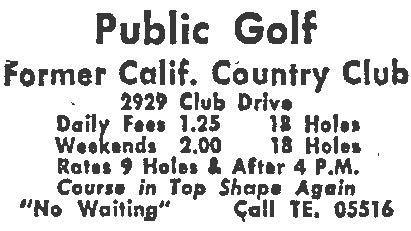
The $325,000 lawsuit by John Montague and by John Kelley’s widow Winifred alleging they were cheated from their share of the sale profits settled for $4,000 in February 1952. “The defendants contended that Montague and Kelley already received $16,500 for their interest in the deal but Atty. Stevens Fargo [1906-1989], who represented Roos and the film men, said $4000 more had been agreed upon to avoid a prolonged trial.” (L. A. Times, Feb. 20, 1952.)
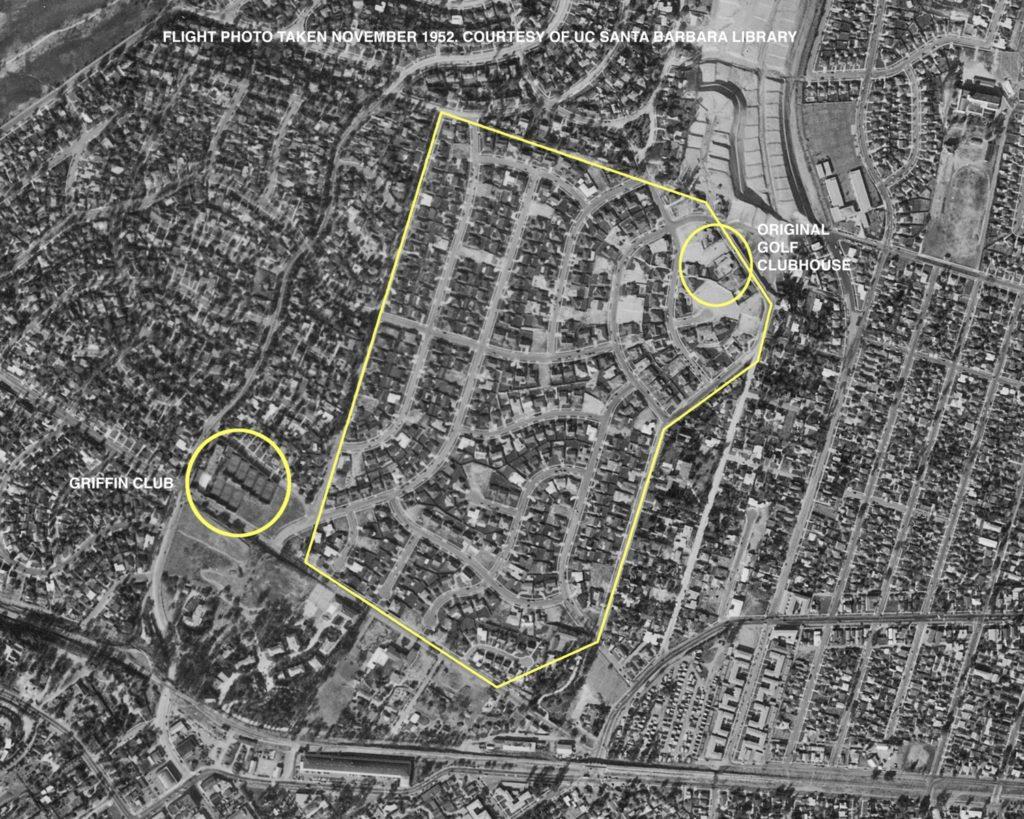
A mid-20th century Cheviot Hills resident, Edward Lawrence (1905-2000), wrote of the country club in “A Bit of Nostalgia” which his widow Helen Elizabeth (Ashby) Lawrence (1908-2012) contributed to the Fall 1998 Cheviot Hills Homeowners’ Association newsletter:
The California Country Club was part of the growing Cheviot Hills community. Eighteen holes sharing the rolling terrain, winding streets and fairways made the area unique and desirable. Little earth was moved. Horse and dray merely touched up the land as nature had created it. …. The fourth hole was a Par 5 dogleg skirting the Tennis Club; the fifth and sixth holes bordered Queensbury. The seventh was a 200‑yard, par 3 over a barranca. California was a challenging links, requiring a variety of shots and never fenced. The Clubhouse was high on a hill, bounded by Club Drive and Shelby. Many celebrities played the course. None quite came up to an exhibition round of Babe Didrikson Zaharias. Her booming shots off the tee sent many a male member to the driving range.
Surviving the depression, the Club became a victim of World War II. Those on the first tee at 9 a.m. December 7, 1941, will never forget the hysterical voice of an announcer over the radio in the golf shop, “The Japanese have bombed Pearl Harbor.” With the drastic loss of members to the Armed Services, the course could not be maintained, water bills could not be met. The land was purchased by a syndicate of film stars as an investment.
Ultimately bulldozers leveled the course for the California Country Club Estates housing development.